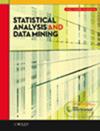基于贝叶斯代理建模分析 COVID-19 数据的考虑因素
IF 2.1
4区 数学
Q3 COMPUTER SCIENCE, ARTIFICIAL INTELLIGENCE
引用次数: 0
摘要
基于代理的模型(ABM)通过模拟被称为代理的自主个体的行为和相互作用,被广泛用于研究传染病的传播。在 ABM 中,代理状态(如感染或易感)根据一套简单的规则分配,疾病传播的复杂动态则由代理随时间变化的集体状态来描述。尽管在现实世界中建模非常灵活,但 ABM 却较少受到统计学家的关注,原因是其似然函数难以处理,导致难以估计参数和量化模型输出的不确定性。为了克服这一局限性,之前有人提出了一种贝叶斯框架,将整个 ABM 视为隐马尔可夫模型。然而,由于计算效率低下和参数的不可识别性,现有方法受到了限制。我们在贝叶斯框架内扩展了 ABM 方法,以研究传染病的传播,从而解决这些局限性。我们采用改进的粒子马尔可夫链蒙特卡洛算法来估计隐含状态(由单个代理随时间变化的状态表示)和模型参数,该算法考虑到了计算效率。我们进一步评估了该方法在参数恢复和预测方面的性能,以及在各种模拟条件下对先验假设的敏感性。最后,我们将提出的方法应用于钻石公主号游轮 COVID-19 疫情的研究。我们研究了主要人口特征在传播方面的差异,同时考虑了两个不同的网络和游轮上有限的 COVID-19 测试。本文章由计算机程序翻译,如有差异,请以英文原文为准。
Considerations in Bayesian agent-based modeling for the analysis of COVID-19 data
Agent-based model (ABM) has been widely used to study infectious disease transmission by simulating behaviors and interactions of autonomous individuals called agents. In the ABM, agent states, for example infected or susceptible, are assigned according to a set of simple rules, and a complex dynamics of disease transmission is described by the collective states of agents over time. Despite the flexibility in real-world modeling, ABMs have received less attention by statisticians because of the intractable likelihood functions which lead to difficulty in estimating parameters and quantifying uncertainty around model outputs. To overcome this limitation, a Bayesian framework that treats the entire ABM as a Hidden Markov Model has been previously proposed. However, existing approach is limited due to computational inefficiency and unidentifiability of parameters. We extend the ABM approach within Bayesian framework to study infectious disease transmission addressing these limitations. We estimate the hidden states, represented by individual agent's states over time, and the model parameters by applying an improved particle Markov Chain Monte Carlo algorithm, that accounts for computing efficiency. We further evaluate the performance of the approach for parameter recovery and prediction, along with sensitivity to prior assumptions under various simulation conditions. Finally, we apply the proposed approach to the study of COVID-19 outbreak on Diamond Princess cruise ship. We examine the differences in transmission by key demographic characteristics, while considering two different networks and limited COVID-19 testing in the cruise.
求助全文
通过发布文献求助,成功后即可免费获取论文全文。
去求助
来源期刊

Statistical Analysis and Data Mining
COMPUTER SCIENCE, ARTIFICIAL INTELLIGENCEC-COMPUTER SCIENCE, INTERDISCIPLINARY APPLICATIONS
CiteScore
3.20
自引率
7.70%
发文量
43
期刊介绍:
Statistical Analysis and Data Mining addresses the broad area of data analysis, including statistical approaches, machine learning, data mining, and applications. Topics include statistical and computational approaches for analyzing massive and complex datasets, novel statistical and/or machine learning methods and theory, and state-of-the-art applications with high impact. Of special interest are articles that describe innovative analytical techniques, and discuss their application to real problems, in such a way that they are accessible and beneficial to domain experts across science, engineering, and commerce.
The focus of the journal is on papers which satisfy one or more of the following criteria:
Solve data analysis problems associated with massive, complex datasets
Develop innovative statistical approaches, machine learning algorithms, or methods integrating ideas across disciplines, e.g., statistics, computer science, electrical engineering, operation research.
Formulate and solve high-impact real-world problems which challenge existing paradigms via new statistical and/or computational models
Provide survey to prominent research topics.
 求助内容:
求助内容: 应助结果提醒方式:
应助结果提醒方式:


